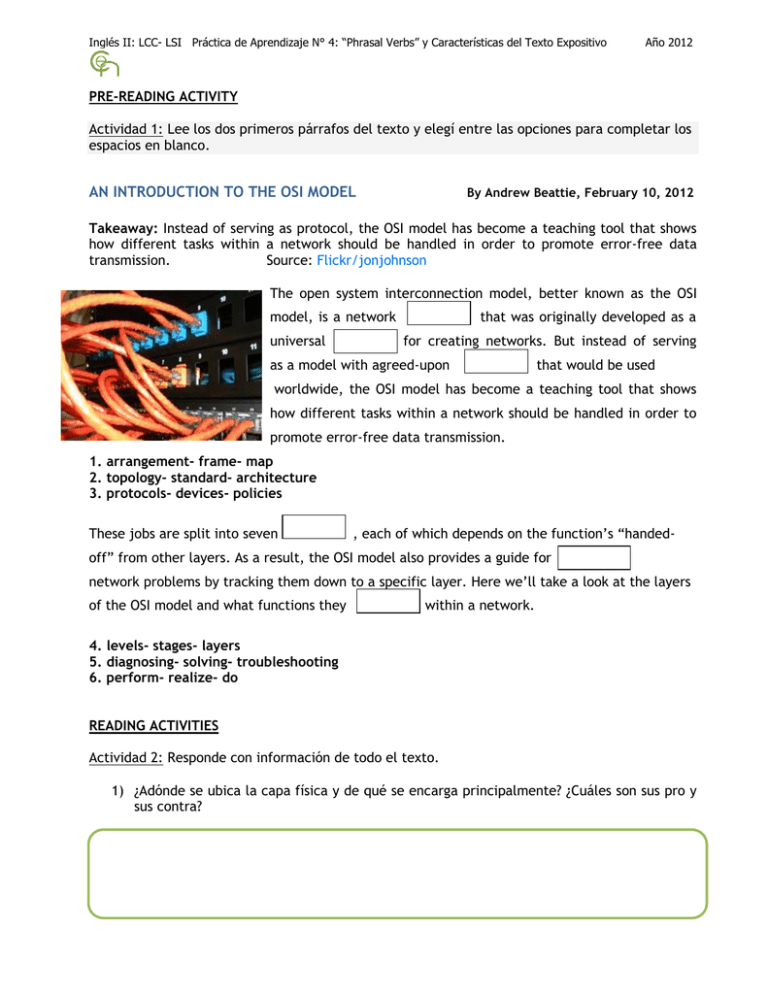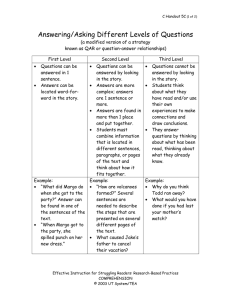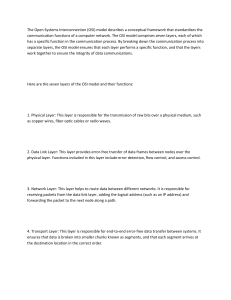AN INTRODUCTION TO THE OSI MODEL
Anuncio

Inglés II: LCC- LSI Práctica de Aprendizaje N° 4: “Phrasal Verbs” y Características del Texto Expositivo Año 2012 PRE-READING ACTIVITY Actividad 1: Lee los dos primeros párrafos del texto y elegí entre las opciones para completar los espacios en blanco. AN INTRODUCTION TO THE OSI MODEL By Andrew Beattie, February 10, 2012 Takeaway: Instead of serving as protocol, the OSI model has become a teaching tool that shows how different tasks within a network should be handled in order to promote error-free data transmission. Source: Flickr/jonjohnson The open system interconnection model, better known as the OSI model, is a network universal that was originally developed as a for creating networks. But instead of serving as a model with agreed-upon that would be used worldwide, the OSI model has become a teaching tool that shows how different tasks within a network should be handled in order to promote error-free data transmission. 1. arrangement- frame- map 2. topology- standard- architecture 3. protocols- devices- policies These jobs are split into seven , each of which depends on the function’s “handed- off” from other layers. As a result, the OSI model also provides a guide for network problems by tracking them down to a specific layer. Here we’ll take a look at the layers of the OSI model and what functions they within a network. 4. levels- stages- layers 5. diagnosing- solving- troubleshooting 6. perform- realize- do READING ACTIVITIES Actividad 2: Responde con información de todo el texto. 1) ¿Adónde se ubica la capa física y de qué se encarga principalmente? ¿Cuáles son sus pro y sus contra? Inglés II: LCC- LSI Práctica de Aprendizaje N° 4: “Phrasal Verbs” y Características del Texto Expositivo Año 2012 1. Physical Layer The physical layer is the actual cable, fibers, cards, switches, and other mechanical and electrical equipment that make up a network. This is the layer that transforms digital data into signals that can be sent down a wire to transmit data. These signals are often electrical but, as in the case of fiber optics, they can also be non-electrical signals such as optics or any other type of pulse that can be digitally encoded. From a networking perspective, the purpose of the physical layer is to provide the architecture for data to be sent and received. The physical layer is probably the easiest layer to troubleshoot but the most difficult to repair or construct, as this involves getting the hardware infrastructure hooked up and plugged in. 2) ¿Qué funciones cumple la capa de enlace? 2. Data Link Layer The data link layer is where information is converted into coherent “packets” and frames that are passed to higher layers. Essentially, the data link layer unpacks raw data coming in from the physical layer and translates information from the upper layers into raw data to be sent over the physical layer. The data link layer is also responsible for catching and compensating for any errors that occur in the physical layer. 3) ¿Cuáles son las principales responsabilidades asignadas a la capa de red? 3. Network Layer The network layer is where the destination for incoming and outgoing data is set. If the data link layer is the highway for cars to drive on, the network layer is the GPS system telling drivers how to get there. Addressing is added to the data by tacking on information around the data packet in the form of an address header. This layer is also responsible for determining the quickest route to the destination and the handling of any problems with packet switching or network congestion. This is the layer where routers work to ensure that data is properly re-addressed before passing it on to the next leg of the packet’s journey. Inglés II: LCC- LSI Práctica de Aprendizaje N° 4: “Phrasal Verbs” y Características del Texto Expositivo Año 2012 4) ¿Cómo garantiza la capa de transporte la calidad y confiabilidad de la comunicación. 4. Transport Layer The transport layer is responsible for streaming data across the network. At this level, the data is not thought of in terms of individual packets but more in terms of a conversation. To accomplish this, protocols -which are defined as “rules of communication- are used. The protocols watch the complete transmission of many packets -checking the conversation for errors, acknowledging successful transmissions and requesting retransmission if errors are detected. The network layer and the transport layer work together like a postal system. The network layer addresses the data, much like a person addresses an envelope. Then, the transport layer acts as the sender’s local postal branch, sorting and grouping all similarly addressed data into larger shipments bound for other local branches, where they will then be delivered. 5) ¿Qué rol desempeña la capa de sesión? 5. Session Layer The session layer is where connections are made, maintained and ended. This usually refers to application requests for data over the network. Whereas the transport layer handles the actual flow of data, the session layer acts as an announcer, making sure that the programs and applications requesting and sending data know their requests are being filled. In technical terms, the session layer synchronizes data transmission. 6) ¿De qué tarea/s se encarga la capa de presentación? 6. Presentation Layer The presentation layer is where received data is converted into a format that the application it is destined for can understand. The work done at this layer is best understood as a translation job. Inglés II: LCC- LSI Práctica de Aprendizaje N° 4: “Phrasal Verbs” y Características del Texto Expositivo Año 2012 For example, data is often encrypted at the presentation layer before being passed to the other layers for sending. When data is received, it will be decrypted and passed on to the application it is intended for in the format that is expected. 7) ¿Adónde se ubica la capa de aplicación, de qué función se encarga y de qué se vale para llevarla a cabo? 7. Application Layer The application layer coordinates network access for the software running on a particular computer or device. The protocols at the application layer handle the requests that different software applications are making to the network. If a Web browser wants to download an image, an email client wants to check the server and a file-sharing program wants to upload a movie, the protocols in the application layer will organize and execute these requests. Putting It All Together We’ve looked at the OSI model from the bottom layer up. A simplified summary of this process can be broken into three requirements: 1. The computer has to be hooked up to a network (physical layer), and must have a way to read data (data link layer). The network must also have a proper address (network layer) to know how to come and go. 2. The network itself has to have ways of efficiently delivering data to the proper recipients (transport layer) and letting those recipients know it has been delivered (session layer). 3. The data has to be unpacked and delivered to the application in a format it understands (presentation layer) and then must fill the requests various software applications make to the network for the user (application layer). Sending data works in the opposite direction, starting at the top OSI layer – the application layer - and moving down through the model, finally ending when the data is received by the recipient via the physical layer. Actividad 3: De acuerdo al orden presentado en el texto (comenzando de abajo a arriba) señalá cuáles de siguientes funciones/tareas realiza cada capa del modelo OSI. Inglés II: LCC- LSI Práctica de Aprendizaje N° 4: “Phrasal Verbs” y Características del Texto Expositivo NÚMERO/CAPA Año 2012 FUNCIÓN/ TAREA Señal y transmisión binaria. Representación de los datos en un formato reconocido por otras capas. Determinación de ruta e IP (Direccionamiento lógico). Ejecutar aplicaciones de usuarios. Sincronización de la transmisión de datos. Conversión de datos. Conexión eficiente/fiable (de extremo-a-extremo). All People Seem To Need Data Processing Please Do Not Throw Sausage Pizza Away Actividad 4: Elaborá una breve conclusión extraída de los dos párrafos finales Conclusion: Lessons From the OSI Model The OSI model provides a conceptual viewpoint of networks by showing what tasks are handled at each level. On a practical level, however, the picture becomes much more complicated. Some devices and protocols fit neatly into a single layer, while others operate in multiple layers and carry out functions that affect every layer. As mentioned, data security in the form of encryption can be confined to the presentation layer, but network security affects all seven layers. Real-world networks are much less defined than the OSI model suggests. That said, the model provides a conceptual framework that can be used to visualize network interactions, both for troubleshooting existing networks and for designing better networks in the future. LET´S FOCUS ON VOCABULARY Actividad 5: Ingresá a: http://www.wordreference.com/es y A) consultá en / qué significado tienen en el texto los siguientes verbos: make up hooked up plugged in drive on tacking on check for broken into carry on B) Averiguá la traducción y la explicación que brindan los glosarios, con respecto a los siguientes términos que aparecen en el texto estudiado. Podes consultar: Inglés II: LCC- LSI Práctica de Aprendizaje N° 4: “Phrasal Verbs” y Características del Texto Expositivo Año 2012 http://www.tugurium.com/gti/contenidos.asp http://www.thefreedictionary.com: a) frame b) addressing c) framework d) troubleshooting POST-READING ACTIVITIES Actividad 6: Escuchá atentamente el video: BRIEF DESCRIPTION OF THE OSI MODEL http://www.youtube.com/watch?v=N8Njjw0ItOE&feature=related y: A) Re-ordená las siguientes ideas: This information enables features such as data encryption, error checking and packet sequencing and reassembling Each packet travels through the layers of the protocol stack When computer 2 receives the packet, the packet travels up the protocol stack At each level the protocols remove the control information, make sure that the message came through without errors, decrypts the information and reassembles the packet into the original message Before sending the message, computer 1 breaks it into packets Let´s look at what happens when computer 1 sends a message to computer 2 over the network When the message arrives at the physical layer it is converted into electrical bits and sent across the transmission media to computer 2 At each layer the protocols add control information to the header of the packet B) Trabaja con la Ficha: Características del Texto Expositivo e identificá cuáles de las mencionadas están presentes en este texto: ¿Cuáles elementos de los nombrados se referencian con “It” y cuáles con “they” Inglés II: LCC- LSI Práctica de Aprendizaje N° 4: “Phrasal Verbs” y Características del Texto Expositivo Año 2012 Con respecto al vocabulario, ¿identificas tecnicismos y/o neologismos en la clasificación que hiciste? ¿Podes encontrar: a) paráfrasis (volver a repetir la información usando otras palabras), b) definiciones, c) ilustraciones, o d) ejemplificación? ¿Qué tiempo verbal predomina? Brinda ejemplos para justificar tu afirmación. Teniendo en cuenta la clasificación de los textos expositivos, ¿cuál de ellas crees que se adapta al texto: “BRIEF DESCRIPTION OF THE OSI MODEL”? C) Observa los esquemas textuales y elegí el que se adapta el texto: “AN INTRODUCTION TO THE OSI MODEL” DESCRIPCION SECUENCIA aspecto TEMA a 1er paso/ etapa/ momento aspecto 2do paso/etapa/ momento aspecto 3er paso/etapa/ momento CAUSA-EFECTO COMPARACION similitudes y diferencias PROBLEMA-SOLUCION Atributo A Característica Aspecto/ rasgo B ....... THE OSI MODEL BY PROFESSOR MESSER http://www.youtube.com/watch?v=lSK1d8fZyEw&feature=player_detailpage HOW TCI/IP WORKS http://www.youtube.com/watch?v=HOaIqQAeaik&feature=related HOW THE INTERNET WORKS IN 5 MINUTES http://www.youtube.com/watch?v=7_LPdttKXPc&feature=related


